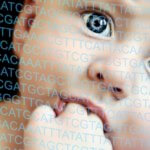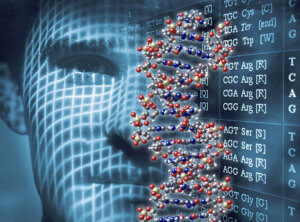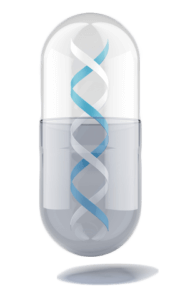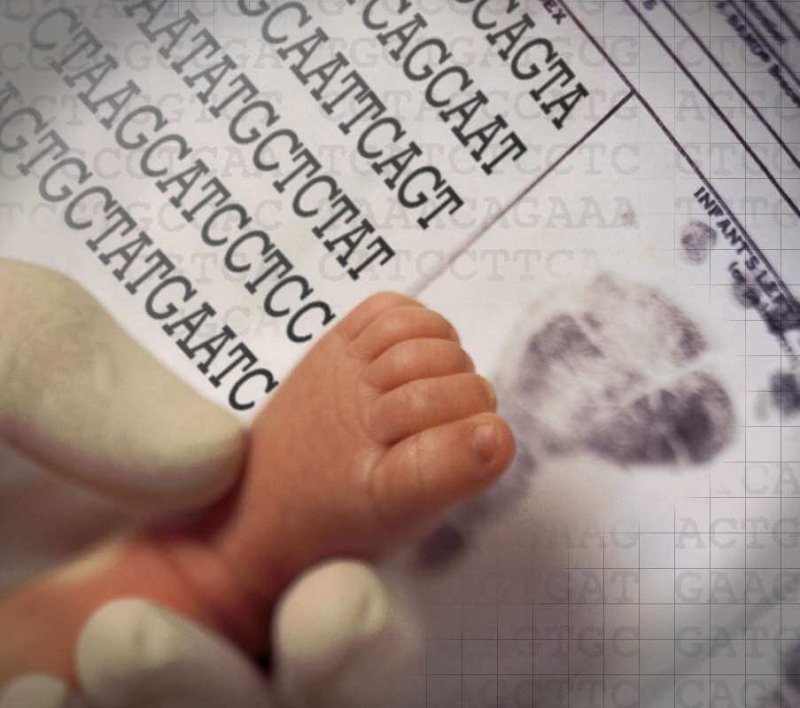Initial findings of the ongoing BabySeq pilot project reported in January 2019 in The American Journal of Human Genetics demonstrate the power of genomics in predicting and preventing illness.
The National Institutes of Health unveiled BabySeq in 2013 with a news release, “NIH Seeks Proposals to Study Genomic Sequencing in Newborn Period.” Using “genomic” instead of “genome” allows wiggle room to count kids who’ve had only their exomes sequenced, the 2 percent or so of the genome that encodes proteins – the parts most often implicated in disease. (The consumer DNA testing companies use far less information, typically a smattering of 750,000 or so SNP markers across the genome.)

The BabySeq “initiative will help us better understand how we can appropriately use this information to improve health and prevent disease in infants and children,” said Eric Green, director of the National Human Genome Research Institute at the beginning.
The project is off to a great start. But if history provides a lesson, routine newborn genomic sequencing won’t come without a fight, or at least objections.
Déjà vu all over again?
Genomic sequencing of newborns has a clinical precedent at the single-gene level: the screening for a few dozen “actionable” conditions that new parents sign off on. The tests are done a day or two after birth on a few drops of blood from a heel prick.
Newborn screening has been ongoing for half a century. The first test was for PKU (phenylketonuria), chosen because a restrictive medical diet from birth can prevent the intellectual disability that would otherwise ensue.
Despite the enormous success of newborn screening (see Baby’s First Test), some people have protested. “The Government Has Your Baby’s DNA” from CNN is a typical headline, omitting the fact that the testing is for the baby’s own good. What to do with the info on stored blood spots has been the subject of much academic debate, but is moot considering that the sequences of A, C, T and G can be digitized, persisting even if the samples are tossed, like for the findings of any genetic test.
Another successful population-wide genetic testing effort is deCODE Genetics, which Wired dubbed “The World’s Greatest Genetic Laboratory.”
 deCODE was the brainchild of Harvard neuropathology professor Kari Stefansson, who founded the “population-based genomics company” in 1996 with $12 million from seven US venture capitalist organizations. It was reborn as NextCODE Health after Amgen bought it in late 2012; a Chinese company took over in 2015.
deCODE was the brainchild of Harvard neuropathology professor Kari Stefansson, who founded the “population-based genomics company” in 1996 with $12 million from seven US venture capitalist organizations. It was reborn as NextCODE Health after Amgen bought it in late 2012; a Chinese company took over in 2015.
Whatever the name, over the years deCODE’s scientists have discovered many health-related gene variants by delving into the genomes of the Icelandic population, descended from just 20,000 or so Viking founders, with little immigration. Against such a uniform gene pool disease-causing mutations stand out, and researchers harvested forests of intertwined family trees. It’s interesting to return to the initial objections to deCODE; I wrote about them two decades ago in The Scientist.
The anti-vaccination campaign that has lead to the return of measles illustrates the danger of distrusting government-sanctioned health tests. Opting out of newborn screening, in contrast, would only affect the particular child, perhaps delaying or missing a diagnosis of a treatable condition.
A clever experimental design
BabySeq was masterminded to maximize information, to test potential value of population-wide implementation. The protocol for the pilot study is described in BMC Pediatrics.
Two Boston area hospitals enrolled 127 healthy newborns and 32 sick babies in the neonatal intensive care unit (NICU). Half of the children in each group had their exomes or genomes sequenced. The parents of all of the participants gave a family history, and since all the babies had the standard heelprick for newborn screening, nobody knew which infants had their DNA sequenced.
For this trial run, the researchers tested the DNA for recessive variants of 310 genes that cause diseases (that is, they detected carriers as well as kids with the associated conditions). They also tested for five genes that elevate the risk of cancer: the two BRCA genes and three for Lynch syndrome (colon and other cancers).

A trove of data
Detailed tables of the recessive diseases festoon the paper, but what’s important overall is the demonstrated value of newborn genomic sequencing.
The sequencing detected childhood-onset diseases that hadn’t yet caused symptoms in fifteen (9.4 percent) of the babies. Ten of them were from the healthy group and five from the NICU group, but none of the discovered mutations were the reasons that the children were in the NICU.
And the findings are indeed actionable.
- Detecting a mutation in a gene that causes hearing loss in teens alerted the care team to direct the parents to treatment that could preserve more hearing.
- A child had a kidney condition that might not have been detected unless a physician knew to look for it.
- The parents of six babies found to have heart muscle conditions were advised to track them with frequent EKGs and echocardiograms, avoid certain stimulants, choose certain sports, and follow a heart-healthy diet.
- Two other conditions found in BabySeq are already detected with newborn screening — biotinidase deficiency and congenital adrenal hyperplasia — but the fuller sequencing picked up rare variants that screening would miss.
 Perhaps the most useful information was pharmacogenetic, alerting parents and eventually their offspring to drugs that could be toxic. Eight of the 159 babies had mutations that would affect drug metabolism: four for fluoropyrimidine cancer drugs, three for thiopurine anti-inflammatories, and one for G6PD deficiency, a common disease worldwide that causes hemolytic anemia under certain conditions, like taking drugs to treat malaria or eating fava beans. (Hannibal Lecter refers to it in The Silence of the Lambs, explained here as involving his witnessing Russian soldiers during World War 2 eating his little sister.)
Perhaps the most useful information was pharmacogenetic, alerting parents and eventually their offspring to drugs that could be toxic. Eight of the 159 babies had mutations that would affect drug metabolism: four for fluoropyrimidine cancer drugs, three for thiopurine anti-inflammatories, and one for G6PD deficiency, a common disease worldwide that causes hemolytic anemia under certain conditions, like taking drugs to treat malaria or eating fava beans. (Hannibal Lecter refers to it in The Silence of the Lambs, explained here as involving his witnessing Russian soldiers during World War 2 eating his little sister.)
BabySeq found 2 babies with a BRCA2 mutation (elevated risk of breast, ovarian, prostate, and pancreatic cancer) and one with a mutation in the MSH2 gene, one of several behind Lynch syndrome (associated with colorectal, endometrial, gastric, and ovarian cancers).
All but one of the predictions was a surprise — no one in the extended family had the condition, although with extra digging a few relatives were found with the cancers or a heart condition.
In addition, 140 of the 159 infants had at least one recessive gene variant that would cause a disease if present in two copies. The median number was two, the most, seven. When these kids grow up, they need only compare these findings, listed on their smartphones or whatever data storage device we have in two or three decades, with their partners’ to predict the risks to their potential children.
Further testing of the parents of newborns with errant genes revealed whether the mutation was inherited from them or originated in the children. That’s important because a mutation in a parent would alert relatives to increased risk, but a child with a “de novo” (new) mutation could only pass it on to offspring. Ten of the 15 babies with mutations had de novo events — that is, a mutation in the egg or sperm, but not a parent. Testing parent-child trios is routine in rare disease diagnosis.
TMI?
A test that reveals actionable findings in nearly a tenth of a newborn population is clearly a positive, promising to shorten or prevent the “diagnostic odyssey” that many families with rare genetic diseases follow. And a genomic profile would provide a resource for medical situations beyond genetic diseases, with information on the physiology of all organ systems perhaps predicting how an individual would cope with other types of diseases.
But like the objections to newborn screening for the few dozen diseases, cataloging so much personal information has downsides.
 How will we protect privacy? The use of genetic genealogy to find a suspect in the case of the Golden State Killer was obviously a good thing. But also it illustrated how DNA sequencing facilitates deducing identity. With a name and DNA profile from GEDmatch and Facebook, it’s not that difficult to find people who might not want to be found.
How will we protect privacy? The use of genetic genealogy to find a suspect in the case of the Golden State Killer was obviously a good thing. But also it illustrated how DNA sequencing facilitates deducing identity. With a name and DNA profile from GEDmatch and Facebook, it’s not that difficult to find people who might not want to be found.
Could genomic information stored at birth be accessed to process an application for preschool? College? A job? To select mates, much as the decades-old program Dor Yeshorim does to weed out recessive diseases in the Jewish community?
Could finding gene variants that hike testosterone production or increase risk for psychosis or narcissism be used against a candidate for political office?
If parents opt out of newborn genomic sequencing and a child develops preventable symptoms, would health insurers deny coverage?
When should the children of BabySeq have access to their data?
The challenge of what to do with genetic information is hardly new, but now it’s no longer a hypothetical. The problem, I think, is that it’s easier to predict applications in precision medicine than it is to imagine how DNA data, from birth, might be misused or abused.
Ricki Lewis is the GLP’s senior contributing writer focusing on gene therapy and gene editing. She has a PhD in genetics and is a genetic counselor, science writer and author of The Forever Fix: Gene Therapy and the Boy Who Saved It, the only popular book about gene therapy. BIO. Follow her at her website or Twitter @rickilewis































